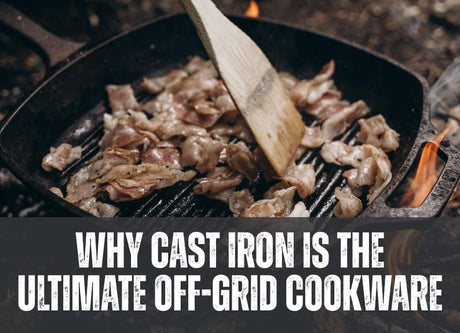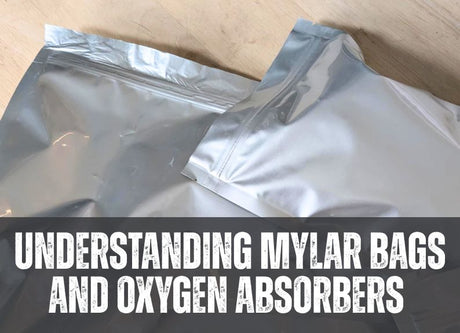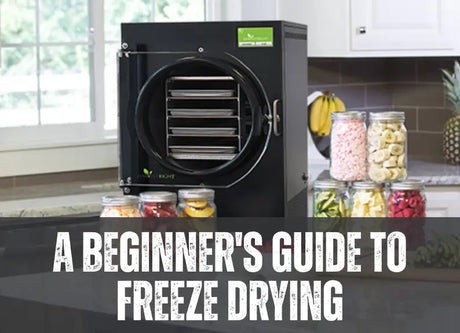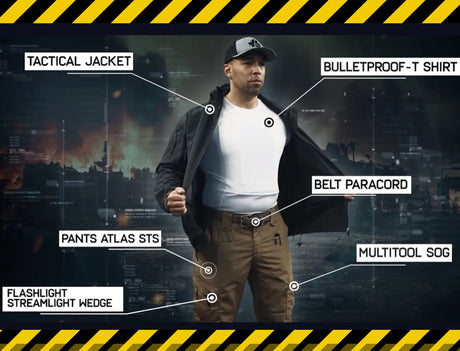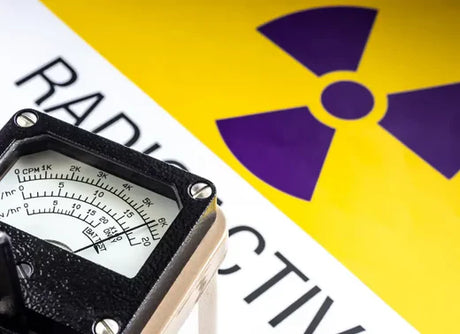In an unfolding disaster, every step you make matters to your survival. In this blog, we developed a preparedness hierarchy of needs for a collapse or emergency situation that you can rely on to keep you calm and increase your chance of survival.
What to do in the first seconds of a societal collapse

Seconds count in a disaster. Your number one priority is protecting yourself from harm when things start to deteriorate. This is why we advocate for having your bugout materials easily accessible at all times, in your vehicle, at your job, and even your gray man bug-out bag to carry with essential supplies. In addition, a pre-practiced emergency plan is an essential tool for your family.
-
Get to safety
This can mean a lot of different things depending on the situation you’re in however, it still remains one of the fundamental principles of survival. In extreme weather, safety might look like the soundest part of your home’s structure, in a nuclear attack, it means getting to the centre of a building or to a bomb shelter or suitable substitute. If you need to quickly escape or evacuate, are you ready to pick up and leave immediately? No matter the situation, it is critical that you have an emergency plan that you understand and review regularly––being prepared is your best chance of survival.
-
Acquire available emergency information
You may only have a very short window to acquire vital information about the situation, what is about to happen, or where to evacuate. It is key that you’re able to access and interpret information quickly so that you can act immediately. A crank-powered radio is an essential item in your bug-out bag, as it does not rely on electricity and allows you to access any information broadcasting. In addition, if there is an attack on your country and telecommunications are disrupted you might need shortwave radios to hear essential information. This requires practice for station tuning and schedules for broadcasting. In war, shortwave radio is an essential communication tool.
A MUST HAVE Prepping/ Survival Item : Solar/Crank Shortwave Radio Kaito 500A
An EASY Guide to Radios for Preppers
-
Protect yourself + your family
In some emergencies, your immediate necessity is to protect yourself. This can mean quickly leaving a situation or self-defence. In either case, physical fitness is a critical component of survival. Fitness and strength is a necessary prep you can start today. When you take care of your health you can ensure that in a time of crisis you have what it physically takes to get yourself out of a situation, fend off an attack, or help someone out of a crisis.
In an active fighting zone, you might want to consider body armour or a plate carrier. In Canada, you may not be able to purchase body armour without an acquisition license for firearms. These rules vary by province, so it is essential to know your province’s legislation. Wearing body armour might make you a target in a dangerous area, so having a grey man solution that is inconspicuous and can be worn under your clothing is a good option. If you have your gun license, having a well-rounded gun to perform in a disaster or emergency and hunting is crucial.
In situations of survival and self-defence, you need a firearm. A shotgun also makes a great versatile hunting tool, a bolt action hunting rifle chambered in 308, or a smaller bore 22 calibre rifle (which is easier to handle and doesn't have as much recoil). The most critical part about using a gun is that you need to have a deep understanding of the safety, use, and storage of firearms. Taking your firearm safety course is an essential prep and one that you can tackle now. In Canada, gun ownership licensing and training varies by province so it is important to become familiar with your local regulations.
What to do in the following minutes of an emergency or disaster.
In the first few minutes following a disaster, the primary concern will be air and securing shelter. The first minutes are essential for enacting your disaster plan and preparing for the next steps in the coming hours.
-
Find better shelter
If you were in a temporary shelter during the initial disaster, it is time to think about how to get yourself to a more secure location as quickly as possible. In a nuclear situation, the fallout will begin to rain down within the first 10-15 minutes after a blast. These first minutes of any disaster are a critical time. If you haven’t developed an emergency plan for yourself and your family, now is the time to make one and practice it. In a crisis, you will revert to automatic memory, and if you’re not prepared, you will be left scrambling. In almost every case, the best place you can be in a disaster is inside. Finding the most structurally stable area of your home, office, or school is a necessity to protect yourself from falling debris or a caved roof.
-
Ensure you have clean air to breathe
As humans, we cannot live more than 3 minutes without access to air. In a disaster like a fire, nuclear attack, disease, and war, often the air quality is the first thing to be sacrificed. Safety equipment, such as a full-face respirator with the necessary filters is an essential item to have in your bug-out repertoire.
-
A particle filter will be necessary for dust, biological contaminants, smoke, tear gas, and nuclear fallout
-
A chemical filter contains a particle filter and provides additional protection from chemicals and toxins with an activated charcoal filter layer
- CO filters incorporate a particle and chemical filter as well as neutralize carbon monoxide.
Avoiding exposure is critical in the first hours of any grid-down
In the coming hours after a disaster or societal collapse, your priorities will begin to shift towards long-term solutions. By this point, you will have been able to collect your bug-out items and move to safety. Perhaps you are awaiting your family and friends to meet at your designated emergency area ready to take the next step in your emergency response plan. Now is the time to collect yourself and calmly determine your next steps.

In the hours following a serious event, it is very likely that power grids will be down, water will be unavailable, and access to emergency services will be limited or unavailable. Your priority is to secure appropriate clothing, bedding, and shelter for the long term. The number one killer of people in survival situations is exposure. Both hypothermia and sunstroke are serious concerns, especially if you are trapped outdoors with limited supplies.
Learn more about how to survive in Canadian winters on our Youtube channel.
The #1 Killer in SHTF: Winter and Thermogenesis
3 things you need to survive in the hours after a disaster:
Warm, durable, and efficient clothing
This is especially critical in Canada, where temperatures can reach as low as -50℃ in the long winter months. Even in the summer, warm and efficient clothing is a necessity.
In the heat, clothing should be lightweight and breathable. While darker colours attract more heat, they may be more inconspicuous, so you will need to assess your situation at the time to determine whether light or dark clothing is appropriate. A large hat and loose-fitting clothing in natural or performance-based fabrics will help to keep you cool in the heat and humidity.
In the winter, layers are critical. Wicking merino wool underlayers, warm and durable mid-layers, and a durable jacket, boots, and ski pants will be necessary for almost the entire country. If you fail to keep your body temperature above 37℃ or 98.6℉ you will become hypothermic. Learn more about how to dress for the cold in our blog.
Cooking and heat

In a survival situation, you can’t just turn on the stove or the furnace. Fire is an essential component of your survival, necessary for both cooking and keeping you warm. In addition, fire can be used as a signal device if you need rescue. There are a number of ways you can cook and keep warm including:
-
To remain discrete you can build a Dakota fire hole which dissipates the smoke from your fire and casts very little light, allowing you to remain discreet
-
Compact cooking stoves are a great option for staying warm in your compatible 4-season tent or in a built structure. They are lightweight and easy to transport and provide ambient heat and a solid cooking surface.
- Solar energy can be used to cook and boil water. A parabolic solar oven uses a reflective dish to harness the power of sunlight to generate energy for cooking. concentrate a large amount so sunlight onto a cooking vessel.
Warm bedding
A warm place to sleep will go a long way in not only preventing hypothermia but also in your capacity to think clearly. Sleeping is not a luxury, it is a key part of regenerating your body for the difficult task of survival.
-
Wool Blanket
Truthfully, there are no synthetic fibres that can stand up to natural ones in their ability to wick moisture and regulate temperature. A military-grade wool blanket is essential for your bug-out bag. It can be used for sleeping, as well as an extra clothing layer.
-
Sleeping bag
A high-quality sleeping bag will regulate your temperature and be durable enough to handle any terrain.
-
Cot
A cot or high-quality sleeping mat will keep you off the ground and help maintain your body temperature. This is especially critical in a colder environment, especially if you are contending with snow or water.
-
Lightweight emergency bivvy
An emergency bivvy is a necessary part of your bug-out preparations. The lightweight bivvy keeps you warm while wicking moisture so that you can stay protected for several days.
When the world collapses, there’s no room for being unprepared.
Starting your emergency planning is your key to survival in apocalyptic level times. Stay tuned for part two of this series to learn more about how to stay alive in the days, weeks, months, and years after the collapse.


